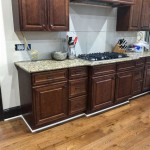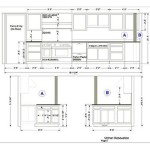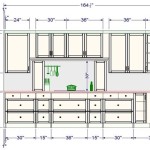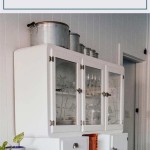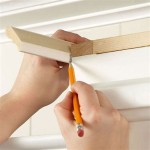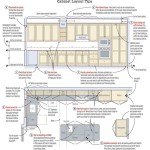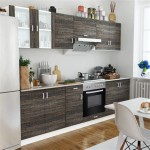How to Organize Your Kitchen Cabinets: A Comprehensive Guide
Kitchen cabinets, often the workhorses of the culinary space, can quickly become chaotic repositories for cookware, pantry staples, and miscellaneous kitchen tools. A disorganized cabinet system not only makes meal preparation a frustrating experience but can also lead to food waste and unnecessary purchases. Implementing a strategic organization system is crucial for maximizing space, improving efficiency, and maintaining a functional kitchen environment. This article provides a detailed guide on how to effectively organize kitchen cabinets, transforming them from cluttered messes into models of order and accessibility.
1. Assess and Declutter: The Foundation of Organization
The initial step in any successful kitchen cabinet organization project is a thorough assessment and decluttering process. This involves emptying each cabinet completely and evaluating the contents.
Begin by removing everything from the cabinets. This allows for a clear view of the available space and simplifies the sorting process. Place items on a large surface, such as a kitchen table or countertop, categorized by type. For example, group all pots and pans together, all canned goods together, and all baking supplies together.
Once everything is removed, thoroughly clean the interior of each cabinet. Wipe down shelves and walls with a damp cloth and a mild cleaning solution. Consider using shelf liners to protect the cabinet surfaces and add a layer of cushioning, especially in cabinets used for storing heavy items.
The next crucial step is to declutter. Examine each item and ask yourself the following questions:
* Do I use this item regularly? If an item hasn't been used in the past six months, it's likely not essential.
* Do I have duplicates? Redundant items take up valuable space. Choose the best version and donate or discard the rest.
* Is this item in good condition? Broken, chipped, or otherwise damaged items should be discarded. Expired food items should also be removed from the pantry.
* Does this item belong in the kitchen? Occasionally, non-kitchen items find their way into kitchen cabinets. Relocate them to their appropriate storage spaces.
Be honest during the decluttering process. Holding onto items "just in case" often leads to continued clutter and impedes efficient organization. Consider donating usable items to local charities or shelters.
2. Strategically Plan Cabinet Zones: Optimizing for Use
After decluttering, the next step is to plan cabinet zones based on usage patterns and proximity to work areas. This involves designating specific cabinets for specific purposes to enhance workflow and accessibility.
Consider the location of different work zones in the kitchen. The area around the stove and oven should be designated for storing pots, pans, baking sheets, and cooking utensils. Items used for meal preparation, such as mixing bowls, measuring cups, and cutting boards, should be stored near the primary prep area.
The cabinet above or near the dishwasher is ideal for storing dishes, glasses, and cutlery. This minimizes the distance required for putting away clean items. Similarly, store frequently used items, such as plates and glasses, in easily accessible cabinets at eye level.
Pantries should be organized by category. Group canned goods together, baking supplies together, snacks together, and so on. Store frequently used items at eye level and less frequently used items on higher or lower shelves. Consider using clear containers to store dry goods, such as flour, sugar, and pasta. This not only keeps the pantry organized but also helps prevent pest infestations and allows you to easily monitor inventory.
Dedicated storage for food preparation tools is key for efficient workflow. Consider using drawer dividers and utensil organizers to keep tools separated and readily accessible. Knife blocks or magnetic strips are ideal for storing knives safely and efficiently.
Spice cabinets can easily become disorganized. To combat this, use spice racks or tiered shelves to keep spices visible and organized. Alphabetizing spices makes it easier to find what you need quickly. Consider labeling containers if the original labels are difficult to read or obscured.
Following this zoning approach will ensure that items are stored in the most logical and accessible locations based on their function and frequency of use. This greatly enhances the efficiency of meal preparation and cleanup.
3. Utilize Organizational Tools and Techniques: Maximizing Space and Efficiency
Selecting and implementing appropriate organizational tools and techniques is pivotal in transforming cluttered cabinets into efficient storage systems. This involves employing a variety of products and strategies to maximize space and improve accessibility.
Shelf Organizers: Adjustable shelves and shelf risers can effectively double or triple the available vertical space in cabinets. These are particularly useful for storing dishes, canned goods, and other items that can be stacked. Corner shelves or lazy Susans can maximize space in corner cabinets, making items more accessible.
Drawer Dividers: Drawer dividers are essential for organizing drawers containing utensils, cutlery, and other small items. They prevent clutter and make it easier to find what you need quickly. Adjustable dividers allow for customization to fit the specific contents of each drawer.
Container Systems: Clear plastic or glass containers are ideal for storing dry goods, such as flour, sugar, pasta, and cereal. They keep food fresh, prevent pest infestations, and allow you to easily monitor inventory. Opt for airtight containers to maximize freshness and prevent spills. Label containers clearly to avoid confusion.
Hanging Organizers: Hanging organizers can be used to store pot lids, cutting boards, and other flat items. They attach to the inside of cabinet doors, freeing up valuable shelf space. Consider using over-the-door organizers for storing cleaning supplies or other small items.
Roll-Out Shelves: Roll-out shelves, also known as pull-out shelves, are an excellent addition to lower cabinets. They provide easy access to items stored at the back of the cabinet, eliminating the need to reach and rummage. These shelves are particularly useful for storing pots, pans, and other heavy items.
Spice Racks: Spice racks come in various forms, including tiered shelves, wall-mounted racks, and drawer inserts. They keep spices organized and visible, making it easier to find what you need. Alphabetizing spices can further enhance organization.
Vertical Dividers: Vertical dividers are useful for storing baking sheets, cutting boards, and other flat items vertically. This maximizes space and prevents items from becoming scratched or damaged.
Cabinet Door Organizers: Attaching organizers to the inside of cabinet doors can create additional storage space. These organizers can be used to store measuring cups, spoons, pot lids, or cleaning supplies. Ensure that the door can still close properly with the organizer in place.
Maximizing Vertical Space: Utilize the full height of your cabinets by stacking items whenever possible. Use shelf risers or stackable containers to maximize vertical space. Consider adding an extra shelf to cabinets that are not fully utilized.
Labeling: Labeling shelves and containers is crucial for maintaining organization. Use clear labels that are easy to read. Regularly update labels as needed to reflect changes in the contents of the cabinets.
Regular Maintenance: Once the cabinets are organized, it's important to maintain the system through regular decluttering and reorganization. Schedule a quick cabinet refresh every few months to remove expired items, reorganize shelves, and discard unwanted items. This will prevent the cabinets from becoming cluttered again and ensure that the organization system remains effective.
By implementing these organizational tools and techniques, you can transform your kitchen cabinets into a highly functional and efficient storage system. The key is to choose tools and techniques that fit your specific needs and preferences, and to maintain the system through regular maintenance and decluttering.

How To Organize Your Kitchen Cabinets Step By Project The Container

How To Organize Your Kitchen Cabinets Step By Project The Container

How To Organize Kitchen Cabinets

How To Organize Kitchen Cabinets In 9 Simple Steps Trusted Since 1922

How To Organize Your Kitchen Cabinets And Pantry Feed Me Phoebe

25 Best Ideas For How To Organize Kitchen Cabinets

How To Organize Your Kitchen Cabinets In 3 Simple Steps Practical Perfection

Organize Your Kitchen Cabinets Using These Easy Tips Hsa
:max_bytes(150000):strip_icc()/crop-silvery-blue-cabinets-2000-70acba9f5faf464aa377714297d92570-a9692c7ba11e44ac86bc8f41c0a9fb42.jpg?strip=all)
How To Organize Your Kitchen Cabinets According Experts

Kitchen S To Organize And Make Your Flow Better
Related Posts

